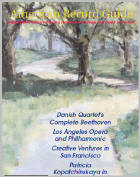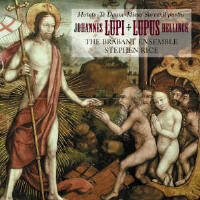Texte paru dans: / Appeared in: |
|
|
Outil de traduction ~ (Très approximatif) |
|
|
Reviewer: Peter
Loewen The program brings together a mass and motets by two composers active in the Netherlands in the first half of 16th Century. Lupus Hellinck (c. 1493-1541), succentor at St Donatian in Bruges from 1523, is well represented by his five-voice Surrexit Pastor Mass. Johannes Lupi (c. 1506-39), choirmaster at the cathedral in Cambrai from 1526, is represented by five of his motets—'Salve Celeberrima Virgo’, 'Quam Pulchra Es’, 'Benedictus Dominus Deus Israel’, and 'Te Deum Laudamus’.
I am very
impressed with the Brabant Ensemble. The soprano voices are wonderfully
light and nimble, and the ensemble as a whole seems to breathe as one. They
make the technical difficulties of this repertory seem almost facile. The 'Surrexit
Pastor Mass’ is a parody of a motet by the Spanish composer Andreas de
Silva, but Hellinck limits his borrowed material to a simple three-note head
motive. The dense polyphony is in line with contemporaries like Nicolas
Gombert, who preferred a relentless interweaving of parts to the more lucid
style of Josquin des Prez. The Sanctus is particularly exciting in its two
Osanna movements. Here quickly rising figures in the upper two parts seem a
perfect fit for the words 'Osanna in excelsis’. Lupi’s counterpoint is
likewise relentless, but there seem to be more striking examples of word
painting among his motets. 'Salve Celeberrima Virgo’ is gorgeous. It calls
for an 8-voice ensemble. One might expect Lupi to indulge more antiphonal
effects, but he seems to eschew these possibilities for a rich interplay of
voices. False-relations in the harmony are striking, suggesting a certain
poignancy in Lupi’s appreciation of the Virgin Mother’s glory and beauty.
The second part, 'Haec Est Illa Dulcissima’, begins with a motive that
bears uncanny resemblance to the opening point of imitation in Josquin’s
famous psalm-motet 'Miserere Mei Deus’. The rising semitone inflection here
adds unexpected poignancy to “illa” (she) in the phrase 'This is she, the
sweetest one’. In the Te Deum each passage of text has a distinct musical
design, as though Lupi were experimenting with textures. Some passages stand
out more than others. For example, on the verse beginning “Per Singulos
Dies” Lupi resorts to an archaic method of improvised polyphony called
fauxbourdon, requiring the high voice to improvise parallel fourths
against the notated tenor, while the bass sings in parallel thirds below.
The effect is stunning, taking his listeners back at least 100 years to the
sound world of the early 15th Century. | |
|
|
|
|
Cliquez l'un ou l'autre
bouton pour découvrir bien d'autres critiques de CD |
|




